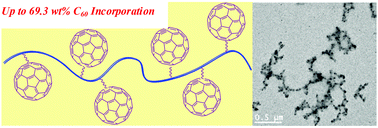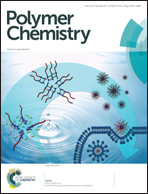Polymeric carbon Lewis base–acid adducts: poly(NHC–C60)†
Abstract
Rapid formation of thermally robust polymeric Lewis adducts between the poly(N-heterocyclic carbene) [poly(NHC)] Lewis base and the carbon Lewis acid C60 is utilized to develop a powerful synthetic strategy for the convenient and efficient synthesis of C60-containing polymers with an unprecedented level of C60 incorporation (up to 69.3 wt%). The resulting polymer Lewis adducts, poly(NHC–C60), exhibit several intriguing properties pertaining to their molecular weights, thermal stability, cross-linking, and morphologies of donor(D)/acceptor(A) blends. Most significantly, the morphology of the D/A bulk heterojunction (BHJ) using poly(NHC–C60) appears to be more controlled and the C60 domain size is apparently much smaller and more uniform, as compared to the D/A BHJ directly using C60 with the same D/A ratio.


 Please wait while we load your content...
Please wait while we load your content...